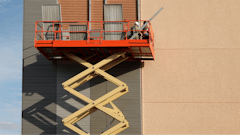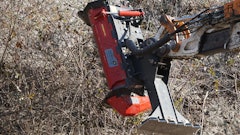If your customer is preparing a garden for planting or renovating their lawn, they'll need a tiller to get started. There are several varieties available; which makes the most sense for your inventory?
Tine is of the essence
To start with, there are three main categories of tillers: cultivators, front- or mid-tine and rear-tine.
Cultivators are lightweight and easy to manipulate for light--duty work. “Usually cultivators have a two-cycle engine with power enough to cultivate or till raised bed gardens or small flower beds,” explains Anne Fisackerly, marketing executive with Maxim Manufacturing. “The cultivator is not suitable for breaking new ground or for large-scale gardening.”
Front-or mid-tine tillers are the most common in rental inventories. This type of tiller has the tines at the front of the machine and a set of wheels and a drag bar in the rear at the operator's position. “With a mid-tine tiller, the tines are more directly under the engine,” notes Mike Smollock with MacKissic. “This provides better balance and control and it also makes it easier to turn... The wheels on this tiller are only used to transport the tiller to the work; once ready to till it is important to pivot the wheels up and lower the drag to a comfortable height. This allows the operator to control the forward motion of the tiller by applying more or less downward pressure on the drag bar.”
Rear-tine tillers are typically used for large-scale jobs or for breaking hard ground that has not been worked before. It has a set of powered wheels up front and tines in the rear, making it more stable and easier to operate because the wheels are powering the tiller along rather than the tines pulling it forward.
According to Larry Seymour, national sales manager at BCS America, there are different types of rear-tine tillers. They include belt-driven, hydraulic and all-gear-driven. Each has its advantages. For example, belt-driven units are simple to operate, hydraulic tillers offer flexibility of use while all-gear-driven machines are very durable. In addition, tillers can offer standard rotation, where the wheels rotate in the same direction as the tines, or they can operate with counter rotation, where the wheels go in the opposite direction of the tines.
“Counter rotation is designed to give maximum depth of till on the first pass,” explains Seymour, noting that this is due to the uppercut motion of the tines. The negative is that wheel traction is a problem when making the second pass.
“This is not a problem for standard-rotating tines, which have the added advantage of being able to chop organic matter without the tines getting wrapped with plant material,” says Seymour.
“A rear-tine will not dig as deep as a mid-tine,” adds Smollock. “Seven to eight inches vs. 10 to 12, but it’s sufficient for most applications.”
Selecting for Rental
When considering a tiller for your rental fleet, there are several things to keep in mind. At the top of the list is your customer base. “You must match your tiller to the clients in your rental area,” says Fisackerly. “Consider what the typical jobs will be, whether you have commercial users (landscapers and contractors) or homeowners, how large the spaces to be tilled are and whether you are in a rural, suburban or urban setting.”
Smollock adds, “Demographics show that most new houses are on much smaller lots than in the past. This means that the mid-tine [tiller] will be the most versatile in these areas. We generally see a store owning four or more mid--tines to every rear-tine tiller. In more rural areas, there are more rear-tines in use.”
Durability is another important consideration. Fisackerly advises looking for a tiller with all-steel construction, a commercial engine with engine guard and a braced frame.
She adds, “A rental tiller must be easy to repair and maintain so you can have faster turnaround times. Look for replaceable tine blades, a repairable transmission, a simple design with few gadgets and quick turnaround on parts orders.”
Smollock says, “Of course with any rental equipment you want to choose a tiller designed for rental use. We feature heavy all-welded tines, stronger transmissions and a cast-iron hitch assembly which secures the transmission, wheels and drag bar and handles.”
Seymour at BCS agrees that durability is a top priority. “In rental, rule number one is it has to perform. Rule number two is it has to come back in one piece.” BCS tillers, he notes, are actually two-wheeled tractors with heat--treated steel gears and shafts, supported by ball bearings and running in oil bath.
As mentioned previously, hydraulic tillers are available and offer a certain degree of flexibility to their operation. Manufacturers, such as Barreto and Maxim, offer models with hydrostatic drives. While more expensive, these machines can offer distinct advantages.
”The [Maxim] Hydrotill is not restricted to a preset high or low speed,” says Fisackerly. “Till at any speed you are comfortable with or the terrain requires.”
Barreto's tiller is bi-directional. It's able to counter rotate on the first pass, to really break up the ground, and then switch to standard rotation on follow up passes to grind up the soil. Greg Barreto, president of Barreto Mfg., adds, “Hydraulic tillers have a relief valve built in to prevent breaking the equipment, especially in rocky ground or new construction sites.”
Hydrostastic tillers do tend to be bulkier, so a trailer might be necessary for transport. Barreto notes that while hydrostatic machines do have more bulk, it can be an advantage. “The heavier the machine, the more work it's going to do rather than working the operator,” he says.
Taking care of your tillers
Maintenance for tillers is fairly straightforward and can be handled successfully with a good pre--season spring check up. “You need to check the belt and pulleys for wear and proper alignment, replace the tine seals seasonally and check the tines to make sure the edges are not worn and the pin holes are not elongated. If the tine edge loses its corner, it will not dig effectively,” says Smollock at MacKissic. “Rear-tine tillers are slightly more complicated as you have a separate wheel drive.”
In general, some primary service points to keep in mind include:
Safety comes first
“Safety begins and ends with customer training,” says Fisackerly, who suggests following these guidelines for a safe tiller rental:
Instruct the customer to do the following:
Many tillers today incorporate an operator presence system that shuts the machine off when the operator lets go of the handlebars. This is a helpful safety feature that can be particularly important to novice users.
Experienced or not, all renters should receive an orientation of the tiller they're renting before they leave the rental yard.
“A very thorough instruction should be given with every rental and most smart rental operators now have the customer sign off that he has received proper instruction and knows how to operate the equipment safely,” says Smollock. “Proper maintenance is critical for safety also.”




























